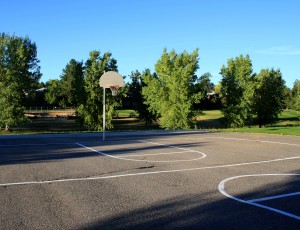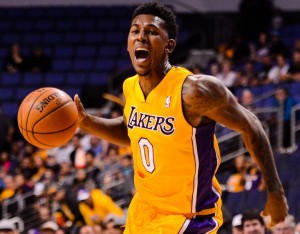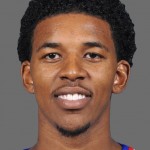 The scorer still looks back nostalgically on those summer days in suburban Los Angeles when he would lace up his sneakers, put on his Lakers jersey and head out to the park.
The scorer still looks back nostalgically on those summer days in suburban Los Angeles when he would lace up his sneakers, put on his Lakers jersey and head out to the park.
Adults and kids of the neighborhood would flock to the playground every afternoon to watch the human mirage in action.
He stood tall at 6-6 and had confidence and moves that were better suited for the Staples Center’s hardwood than Reseda’s blacktops. From afar, if you didn’t know any better, you’d think he was Kobe Bryant taking an opportunity to give back to the local community.
He committed to play college ball at USC, where he blossomed into one of the best players in the country. He made two All Pac-10 teams and led the Trojans to a convincing rout over Kevin Durant’s Texas Longhorns in the NCAA Tournament as a junior.
That was 2007, when the future looked as promising for Nick Young as it did for just about any prospect in the country. In the seven years since, however, Young’s talents and successes have largely been dismissed as NBA executives and sabermetricians have shifted to respect scorers at historically low levels.
Young deserves more credit than he gets.
Imagine your ideal shooting guard in the NBA.
1. He’d probably be around 6-6.
2. He’d be a lethal shooter from deep.
3. He’d be freakishly athletic with several acrobatic finishes in his arsenal around the hoop.
4. He’d be able to create a shot for himself whenever he needed.
5. His wingspan would probably be around seven feet.
6. His ballhandling skills would be elite for his size.
7. He’d be hungry to improve, attending early film sessions before practice and staying late to get in extra shots.
8. His coach would love his effort on defense and would call him a great presence for the locker room.
How many players in the league meet all of those criteria? Off the top of my head, the only guys I can think of are Paul George, Andre Iguodala (this season) and Young. When it comes to pure talent, he’s simply one of the most physically gifted basketball players in the world.
Still, you’re probably laughing at the idea of calling Nick Young an “ideal shooting guard.”
Why is that?
I think it has something to do with his role on the court and demeanor off it. He’s a self-proclaimed “pure scorer,” which in today’s NBA is code for “inefficient heat check gunner.” His self-coined nickname, “Swaggy P,” is just as ridiculous as it sounds. He plays with undeniable swagger, but even he couldn’t tell you the origins of where the “P” comes from. Despite being the Lakers’ leading scorer, he’s a distant second in his family to cousin – rapper Kendrick Lamar – in terms of popularity in Los Angeles.
It’s not exactly a stretch to assume a player like Young would be an egomaniac. After all, he’s unabashed to hoist up 20 difficult shots on any given night, which naturally leads some to conclude that he’s selfish and fails to buy into the concept of teamwork.
But Young is nothing like the stereotype. He’s genuine and always seems to be smiling. Around the locker room, his positive attitude has become something coach Mike D’Antoni calls “invaluable” for the team.
“Without a doubt, his personality has helped us in the locker room and on the floor,” D’Antoni said. “He’s one of those guys who’s always positive. He’s funny, but he’s not silly. He never messes a play up and he always comes out and adds energy in positive ways at practice and at shootarounds. He’s the first guy to get everybody going.” 
Still, when most people think of Young, they think “chucker” before “locker room leader.”
If you watch any given Lakers’ game, you will likely see Young hoist a contested deep shot at some point. By the end of the night, he might end up with 20-plus points but few of his shots will have been quality looks.
It’s natural to think he’s inefficient.
On the contrary. Young’s efficiency as a scorer has been unprecedented for a player who’s better known for quantity rather than quality.
For the season, Young is averaging 0.43 points per touch. That’s the exact same rate as Kevin Durant. Among healthy players averaging more than 25 minutes per game, only Klay Thompson has scored more efficiently per touch.
Young is also averaging 1.26 points per shot. LaMarcus Aldridge, an MVP candidate who is best known for his automatic mid-range game, is averaging 1.13 points per shot. Clearly, Young reputation as a chucker is outdated.
Still, people watch Young execute plays like this and conclude he has no idea what’s going on.
These moments of aloofness are few and far between at this point in Young’s career. Nowadays, when you closely watch Young play, you see a player showing true signs of understanding on offense and effort and hustle on defense.
He may never develop into a lockdown defender but he has established a niche role on the Lakers by utilizing his length to handle versatile defensive assignments. (He primarily defended Dwyane Wade on Christmas but also took turns on LeBron James and Ray Allen.) Young also leads the Lakers in charges drawn, something that has impressed Pau Gasol.
“He’s come up with big charges,” said Gasol. “I think he’s taken the most charges on the team and he’s worked hard to understand the importance of that end of the floor.”
D’Antoni went a step further:
“I’ve loved his attitude and I’ve loved the way he’s trying on defense,” the coach said. “He’s done everything we’ve asked of him and more.”
Perhaps the best evidence of Young’s effectiveness on defense can be found in his impact for the team when on the court.
 For the season, opponents have outscored Los Angeles by 3.4 points per 100 possessions, placing them 22nd in the league in net rating and ahead of usual suspects New York, Sacramento, Brooklyn, Memphis, Cleveland, Milwaukee, Philadelphia and Utah.
For the season, opponents have outscored Los Angeles by 3.4 points per 100 possessions, placing them 22nd in the league in net rating and ahead of usual suspects New York, Sacramento, Brooklyn, Memphis, Cleveland, Milwaukee, Philadelphia and Utah.
However, when Young is on the court out of the sixth man role, the Lakers have flipped the script and have outscored opponents by 3.8 points per 100 possessions, which is on par with Golden State and Phoenix’s net ratings.
In other words, when Young comes in as a sixth man, Los Angeles becomes approximately 7.2 points better per 100 possessions.
Knowing this, it’s fair to say Young might be the most underappreciated player in the league. He has turned himself into an extremely consistent volume scorer, which is something of an oxymoron in today’s NBA.
“I had always seen him score [when he was with other teams] but I think he’s been very consistent with us,” said Gasol. “He hasn’t been as streaky as I’ve seen him with other teams, so I think he’s matured. He’s really finding consistency this year so he’s been a big help for us.”
How many people recognize this? Young’s positive impact for the Lakers goes beyond the visual aesthetics he brings with every 3-pointer made. (He’s at a respectable 37 percent from deep for the season.)
“Scoring takes a lot of hard work,” he said. “It takes a lot of long nights of practicing and shooting. Everybody in this league can score. But there’s an art to being really good at the talent.”
Young’s failure to garner respect, while not obvious on the court when opponents’ best perimeter defenders guard him, has been apparent in past free agent markets.
No team has ever offered Young a long-term contract, and the Lakers were able to sign him for the veteran’s minimum last summer. Young is only 28 and three seasons removed from leading the Washington Wizards in scoring at 17.4 points. I have trouble believing he’s not at least as valuable as big men such as Zaza Pachulia or J.J. Hickson, who both received three-year, $15 million deals over the summer.
“That’s what’s sad and what gets me angry during free agency,” admitted Young. “It’s tough. Scorers don’t get as much respect as we should. When free agency comes around and players like J.R. Smith are only getting what he got as the Sixth Man of the Year, it’s just tough.”
One way Young could change the unfair negative perception around him is by actively looking to pass more. With as much offensive talent as he possesses, it is somewhat surprising that he doesn’t take more advantage of his distributing opportunities.

“As a scorer, you get a lot of attention so you can create for others,” he acknowledged. “But I take the distributing as it comes. I don’t want to go out there and set my mind on one thing. When everything is happening, if the defense is double-teaming, I’ll obviously look to pass the ball.”
One blatant problem for Young is that he still passes at abnormally low levels. For the season, he is averaging only 21.2 passes per game. To put that in context, a team’s leading perimeter scorer usually averages between 40-50 passes per game.
Young’s 21.2 passes come in 27.6 minutes. Comparatively speaking, Charlotte rookie Cody Zeller — a forward with limited offensive skills — averages 34.4 passes in only 18.0 minutes.
And yet, when Young does pass, good things usually happen. Young averages 3.5 assist opportunities per game – good for one assist opportunity in every 6.1 passes he makes. This rate is consistent with most point guards in the league. Damian Lillard averages an assist opportunity every 5.7 passes while Jose Calderon averages an assist opportunity every 7.2 passes.
Surprisingly, Young is actually an extremely talented passer when he looks to distribute.
Take this play from last season with the Sixers as an example. As Young drives, he commands help defense from both Vince Carter and Elton Brand because his reputation tells them he’s going to shoot. To everyone’s surprise, he finds Dorell Wright with a beautiful no-look pass.
More often, however, Young’s strong drives lead to unconverted open shots for teammates. The Lakers are among the league’s worst at converting assist opportunities.
Take this play in Atlanta from last month as a primary example:
– Young finds Meeks for uncontested three pointer
Other times, Young will drive the ball and command help defense to come over. When this happens, he usually finds teammates for quick drives to the hoop:
– Young draws double-team and hits Henry for easier drive to the hoop
Young doesn’t get credit for the assist on this play, but it was his initial move that gave Henry enough space to drive to the rim and draw the foul.
At the end of games, defenses occasionally double-team Young. He is steadily getting better at finding open teammates and racking up “hockey assists” more consistently after these double-teams. These two plays highlight his improvements:
– Young with the easy hockey assist out of the double team
– Young’s quick pass leads to open Wesley Johnson three pointer
“I wouldn’t call him a playmaker, but he’s a guy who can make plays,” D’Antoni said. “And that’s not trying to be funny because he’s good. He can get a shot off as well as anybody in the league. He’s learning to balance making the right plays and learning that means not always shooting. He’s making unbelievable improvements.”
For hypothetical purposes, how many assists could Young rack up if he put in the concentrated effort to distribute more often?
Portland’s Mo Williams comes off the bench with a distributor’s mindset and averages 8.6 assist opportunities on 43.1 passes per 24.5 minutes.
If Young passed at Williams’ rate, he would speculatively double his assist opportunities to seven per game. If the Lakers’ conversion rate remained the same, Young would average approximately 3.5 assists per game.
 This would push Young into the exclusive club of players who average at least 20 points and 4.5 assists per 36 minutes. The club currently includes only Durant, Wade, Lillard, LeBron James, Russell Westbrook, Kyrie Irving, James Harden, Isaiah Thomas, Tony Parker, Chris Paul and Monta Ellis.
This would push Young into the exclusive club of players who average at least 20 points and 4.5 assists per 36 minutes. The club currently includes only Durant, Wade, Lillard, LeBron James, Russell Westbrook, Kyrie Irving, James Harden, Isaiah Thomas, Tony Parker, Chris Paul and Monta Ellis.
“If Nick wanted to work on his playmaking abilities with assists, he could do that,” fellow Lakers guard Xavier Henry said. “You just have to think differently (as a distributor). You can’t just go out there and get yours. You have to make sure everyone’s getting involved in the game.”
In his limited time as the Lakers’ point guard earlier in the season, Kobe Bryant acknowledged that shifting from scorer to facilitator required a little more focus.
“It’s just trying organize things, really,” said Bryant. “That’s really it. It’s new because you have to figure out who likes doing what at certain times in the game. It takes a little adjusting.”
Young has thought about becoming more of a distributor and what racking up more assists could mean for him as an upcoming free agent.
Still, he looks back on advice he received as a rookie from none other than Kevin Garnett and remains confident that scoring is his biggest asset for the team.
“KG told me a long time ago, ‘If you’re a scorer, be a scorer. Don’t try to be something you ain’t,'” Young said. “You go in there and tell them, ‘You pay me to score and do what I do.’ As you grow, you’ll learn everything else. As a first goal though, just do what got you here.”
Besides, Young has finally found an offense and coach who encourage him to play with absolute freedom.
“He has the green light to make plays,” D’Antoni said.
And because this green light has continued to yield efficient scoring for the depleted Lakers’ offense, Young has every reason to continue firing away.
“If scoring is my thing to help the team, I’m just going to do what I can to help the team win.”
Jacob Eisenberg is a junior at Emory University and works as a credentialed reporter at Atlanta Hawks games. Check out his website here and be sure to follow him on twitter @eisenberg43.
That’s a cunning answer to a challenging question
That’s a slick answer to a challenging question
As Charlie Sheen says, this article is “WINNING!”
You’re on top of the game. Thanks for sharing.
That’s really thinking at a high level
It’s great to read something that’s both enjoyable and provides pragmatisdc solutions.
Wham bam thank you, ma’am, my questions are answered!
Well put, sir, well put. I’ll certainly make note of that.
THX LOVE SWAGGY P!
That’s a genuinely impiessrve answer.